Europe
Asia
USA
...
| International | ||
|
Australia & East Timor |
|
|
|
|
||
|
|
||
|
|
||
|
|
||
|
|
||
|
|
||
|
|
||
|
Argentina
|
|
Carmel in Argentina |
|
Bolivia
|
|
|
|
Brazil |
|
|
|
|
Homepage of the Pernambuco Province | |
|
Czech Republic |
|
|
|
France |
|
|
|
Germany |
|
|
|
Great Britain |
|
|
|
|
Carmelite Institute of Britain & Ireland | |
|
India
|
|
Homepage of the Indian Province |
|
Indonesia |
|
|
|
Ireland |
|
|
|
|
Carmelite Institute of Britain & Ireland | |
|
Italy |
|
|
|
|
Homepage the Province of Naples | |
|
|
Carmelite Institute, Rome | |
|
Malta |
|
|
|
Netherlands |
|
|
|
|
||
|
Peru |
|
|
|
Poland |
|
|
|
Portugal
|
|
|
|
Spain
|
|
Homepage of the Arago-Valentina Province |
|
United States of America |
|
|
|
|
||
|
|
||
|
|
The Carmelitana Collection | |
| Centre for Carmelite Studies, CUA, Washington | ||
|
|
||
Carmelite’s National Treasure
It has been called “a national treasure” but for well over 100 years it has been accessible to just a few.
Now that has changed. The Carmelite Library – Australia’s finest specialised collection of books and journals in the area of Christian spirituality and mysticism – has a permanent home in Middle Park.
And it welcomes both “the scholar and the seeker” to make use of its rich resources.
The Carmelite friars arrived in Australia from Ireland in the early 1880s and brought with them the nucleus of today’s Carmelite Library.
Among its treasures were the Ceremoniale of 1616 which guided the priest through the intricacies of celebrating mass according to the Order’s ancient Rite of the Holy Sepulchre which dated to the time of the Crusades; and the Carmelite Constitutions of 1625 (reprinted 1721) then still in force.
In 1928 the Carmelites began training their Australian novices and students in Melbourne rather than send them to Ireland. An academic library began to develop at Whitefriars House of Studies, which was first in Kew and from 1937 in Donvale.
It included the textbooks and other works required by the students and their professors across a broad philosophical and theological range. By the 1980s financial pressures, the development of new theological centres and the Order’s changing educational strategy prompted a change of policy and focus.
In 1985 it was decided to discontinue collecting across the whole range of theological disciplines and today the library is concentrated in three areas closely associated with the life and spirit of the Order. These are:
- Carmelitana: all aspects of the life, history and spiritual tradition of the Order;
- Spirituality: the Christian spiritual and mystical tradition, both historical and contemporary, and its links to other world spiritual traditions;
- Mariology: the theological study of the Virgin Mary.
The Rare Book Collection includes about 300 pre-1800 titles, most of them with a Carmelite connection. The oldest book, a controversial work against Lutheranism by the Italian Carmelite Giovanni Maria Verrato, dates from 1538.
In 2003 the Library contained some 30,000 books and other items and is housed in the heritage Carmelite Hall next to the Church of Our Lady of Mount Carmel, Middle Park, where the Carmelites have ministered since 1882.
New Management
The Carmelites know the library requires further development if it is to realise its potential as a cultural, intellectual and spiritual resource for the Australian community. To this end, the Carmelites have formed a partnership with the University of Divinity for the management of the Library from October 2023 to December2024. During this time the University team will work with the Carmelite Library Interim Board to collaboratively develop recommendations as to the most appropriate long-term structure for the library's operation.
Open again
To enable the University team to prepare for this project, the Carmelite Library was closed to the public on 28 September 2023 and reopened on 6 February 2024.
- You can email This email address is being protected from spambots. You need JavaScript enabled to view it. with any enquiries.
- You can visit the Library website by clicking here.
- You can access the Library catalogue by clicking here.
Carmelite Library
214 Richardson Street, Middle Park, Victoria 3206 Australia
Tel : (03) 9682 8553
Email: This email address is being protected from spambots. You need JavaScript enabled to view it.
Open Tuesdays 10am - 3pm
Download the Carmelite Liturgical Guide for this year -
pdf
2025 Carmelite Liturgical Guide [PDF] |
default
2025 Carmelite Liturgical Guide [ePub]
JANUARY
3 St Kuriakos Elias Chavara (CMI), Priest, Optional Memorial in India
8 St Peter Thomas, Bishop, Feast
9 St Andrew Corsini, Bishop, Feast
20 Bl. Angelo Paoli, Priest, Optional Memorial, Memorial in Italy
29 Bl. Archangela Girlani, Virgin, Optional Memorial in Italy
FEBRUARY
1 Bl. Candelaria of St Joseph, Virgin, Optional Memorial in Latin America
MARCH
19 St Joseph, Spouse of the Virgin Mary, Principal protector of the Order, Solemnity
APRIL
17 Bl. Baptist Spagnoli, Priest, Memorial
MAY
4 Bl. Angel Prat Hostench & Companions, Martyrs, Optional Memorial
5 St Angelus, Priest and Martyr, Memorial
8 Bl. Aloysius Rabatà, Priest, Optional Memorial
9 St George Preca, Priest, Optional Memorial
16 St Simon Stock, Religious, Optional Memorial
22 St Joachina de Vedruna de Mas, Religious, Optional Memorial
25 St Mary Magdalene de' Pazzi, Virgin, Feast
JUNE
12 Bl. Hilary Januszewski, Priest and Martyr, Optional Memorial
14 St Elisha, Prophet, Memorial
JULY
4 Bl. Maria Crocifissa Curcio, Virgin, Optional Memorial in Italy
9 Bl. Jane Scopelli, Virgin, Optional Memorial
13 St Teresa of Jesus 'de Los Andes' (OCD), Virgin, Optional Memorial in Latin America
16 Blessed Virgin Mary of Mount Carmel, Solemnity
17 Bl. Teresa of St Augustine and Companions (OCD), Virgins and Martyrs, Optional Memorial
20 St Elijah, Prophet, Solemnity
24 Bl. John Soreth, Priest, Memorial
26 St Joachim and St Anne, Parents of the Virgin Mary, Protectors of the Order, Memorial
27 St Titus Brandsma, Priest and Martyr, Memorial
AUGUST
7 St Albert of Trapani, Priest, Feast
9 St Teresa Benedicta of the Cross (OCD), Virgin and Martyr, Memorial (Feast in Europe)
12 Bl. Isidore Bakanja, Martyr, Optional Memorial
17 Bl. Angelus Augustine Mazzinghi, Priest, Optional Memorial
25 Bl. Mary Baouardy of Jesus Crucified (OCD), Virgin, Optional Memorial
26 Bl. Jacques Retouret, Priest and Martyr, Optional Memorial
SEPTEMBER
1 St Teresa Margaret Redi (OCD), Virgin, Optional Memorial
17 St Albert of Jerusalem, Bishop and Lawgiver of Carmel, Feast
OCTOBER
1 St Thérèse of the Child Jesus (OCD), Virgin and Doctor of the Church, Feast
15 St Teresa of Jesus, Virgin and Doctor of the Church, Feast
NOVEMBER
5 Bl. Frances d'Amboise, Religious, Optional Memorial
6 St Nuno Alveres Pereira, religious, Memorial
8 St Elizabeth of the Trinity (OCD), Virgin, Optional Memorial
13 Bl. Maria Teresa Scrilli, Virgin, Optional Memorial in Italy
14 All Carmelite Saints, Feast
15 Commemoration of all Carmelite Souls
19 St Raphael of St Joseph Kalinowski (OCD), Priest, Optional Memorial in Poland
29 Bl. Denis of the Nativity (OCD), Priest and Martyr, and
Bl. Redemptus of the Cross (OCD), Religious and Martyr, Optional Memorial
DECEMBER
5 Bl. Bartholomew Fanti, Priest, Optional Memorial
14 St John of the Cross, Priest and Doctor of the Church, Feast
As approved by the Dicastery for Divine Worship and the Discipline of the Sacraments
18 November 2021
Change of Titus Brandsma (27 July) from Optional to Obligatory Memorial approved by the Dicastery for Divine Worship and the Discipline of the Sacraments
25 May 2023
30 October 1802 – Lay Carmelites James Dempsey and John Butler arrive in Sydney aboard the Atlas having been transported for life for their alleged involvement in the Irish Rebellion of 1798. Butler died on April 4, 1836 and Dempsey on February 10, 1838.
7 May 1824 – Father Samuel Coote, an Irish Carmelite, arrived in Hobart aboard the Ardent to minister among the Catholics of Van Diemen's Land. He was only the fourth priest to come free to work in Australia, but left the colony for England in December 1825 and died in London on September 18, 1837.
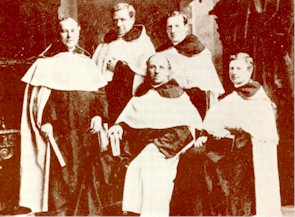 16 April 1881 – Irish Carmelites Joseph Butler, Ignatius Carr, Patrick Shaffrey, Brocard Leybourne and Hilarion Byrne (pictured right) arrive in Port Adelaide aboard the SS Liguria to begin the Australian Mission. It was Holy Saturday that year and the Prior of the Mission, Joseph Butler, continued on to Gawler the same day to celebrate his first Mass in Australia on Easter Sunday.
16 April 1881 – Irish Carmelites Joseph Butler, Ignatius Carr, Patrick Shaffrey, Brocard Leybourne and Hilarion Byrne (pictured right) arrive in Port Adelaide aboard the SS Liguria to begin the Australian Mission. It was Holy Saturday that year and the Prior of the Mission, Joseph Butler, continued on to Gawler the same day to celebrate his first Mass in Australia on Easter Sunday.
7 May 1882 – Carmelites celebrate their first Mass in St Joseph's Church, Port Melbourne, Fathers Butler and Shaffrey having accepted charge of the newly-formed parish of Sandridge.
October 1886 – Opening of Priory on Beaconsfield Parade.
January, 1902 – Carmelites move from Gawler to the parish of Port Adelaide. Carmelites withdrew from the Parish of Port Adelaide/Pennington on 10 January 1999.
1909 – Division of Sandridge parish into the parishes of Port Melbourne and Middle Park and establishment of separate priories.
28 June 1928 – Foundation of first Australian Novitiate at St Vincent’s Place, Albert Park, Vic. The Novitiate and House of Studies moved to Whitefriars, Kew in 1930 and then to Whitefrairs, Donvale in 1937. In 1946 the Novitiate was established in Wahroonga, NSW and moved from there to Hunters Hill in 1956 then to Lawson and in 1964 to Winston Hills. In 1974 the Novitiate returned to Donvale and moved to Vermont in 1976, returning to Donvale in 1977. In 1984 the Student House moved from Donvale to North Box Hill, returning to Donvale in 1986. The Novitiate and House of Studies were combined at Port Melbourne in 1987, returned to Whitefriars, Donvale in 1990, returning to Port Melbourne in 2000. In 2005 the Novitiate and House of Studies moved to Middle Park.
22 March 1930 – Foundation of the Australian Commissariat. Father Robert Power first Commissary General.
January, 1937 – Foundation at Cavendish Road, Coorparoo.
26 August 1937 – Opening of Whitefriars Monastery, Donvale, VIC by Archbishop D Mannix. Monastery was sold on 25 January 2002.
1947 – Foundation of the Lay Carmelites in Australia by Father E.J. Nugent.
13 September 1948 – Foundation of the Australian Province. Father E.J. Nugent first Provincial.
January, 1949 – Foundation at Meadowbank, New Zealand. Foundation closed in 1970.
1956 – Frs William Morganti and Robert Dowd together with Br George Parsons went to Southern Rhodesia (now Zimbabwe) to join the Carmelite mission which had been established by the Irish Province in 1946. The Province’s involvement continued until 1961.
1956 - Foundations at Hilton and Wentworthville. Foundation in Hilton closed on 31 January 2005.
1961 – Foundation of Whitefriars College at Donvale, VIC.
1973 - At the invitation of the Indonesian Province, the Australian Province took over the mission in Sumbul in North Sumatra in March 1973 and continued to have responsibility for it until 1982. In that year Fr Anthony Scerri, who had been parish priest in Sumbul, became vice rector of the new St Thomas’ University in Medan and remained there until September 1995 when he was elected General Councillor. The Australian mission in Indonesia ceased at that date.
27 January 1977 – Foundation of the House of Prayer at Vermont which moved in 1978 to Warburton, and of the Whitefriars College community firstly at East Doncaster, then at McGowans Road, Donvale in 1978 and finally at Merinda, Donvale in 1979.
8 May 2001 - Provincial Chapter: The Australian Carmelites accept the invitation of the Indonesian Carmelites to incorporate Timor-Leste (East Timor) as part of the Australian Province.
16 August 2001 – The Australian Carmelites accept responsibility for the Carmelite Presence in Timor-Leste and for the Mission Parish of Zumalai.
2 August 2004 - Foundation of the first Timor-Leste Novitiate at Fatuhada, Dili.
24 September 2004 - Change of Province name to ‘Australia and Timor-Leste’
22 January 2005 - Reunification of the parishes of St Joseph, Port Melbourne and Our Lady of Mount Carmel, Middle Park as one parish.
20 July 2005 - Foundation of Titus Brandsma Community, Fatuhada, Dili.
17 April 2007 - Foundation of St Elijah Novitiate in Hera, Timor-Leste.
29 July 2009 - Carmelite Centre formally launched by Fr Wayne Stanhope, Prior Provincial.
8 May 2010 - Blessing & opening of St Nuno Student House, Hera, Timor-Leste.
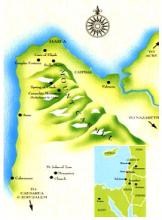 Origins & growth
Origins & growth
The Order of Carmelites has its origins on Mount Carmel, in Palestine, where, as we read in the first Book of Kings, the great prophet Elijah defended the true faith in the God of Israel, when he won the challenge against the priests of Baal. It was also on Mount Carmel that the same prophet, praying in solitude, saw the small cloud which brought life-giving rain after the long drought. From time immemorial, this mountain has been considered the lush garden of Palestine and symbol of fertility and beauty. Indeed, "Karmel" means "garden".
In the 12th century (perhaps after the third crusade, 1189-1191), some pilgrims who had come from Europe, came together near the "spring of Elijah", in one of the narrow valleys of Mount Carmel, to live out their Christianity as hermits after the example of the prophet Elijah in the very land of our Lord Jesus Christ. Then and in later times, the Carmelites did not acknowledge anyone in particular as their founder, but remained faithful followers of Elijah who was associated with Mount Carmel through biblical events and through Greek and Latin patristic tradition which saw in the prophet one of the founders of the monastic life. In the middle of the cells they built a chapel which they dedicated to Mary, Mother of Jesus, thus developing a sense of belonging to Our Lady as Patroness, and they became known by her name as "Brothers of Saint Mary of Mount Carmel". Thus Carmel is deeply associated with Elijah and Mary. From Elijah the Carmelites inherited a burning passion for the living and true God and the desire to make His Word intimately their own in order to witness to Its presence in the world; with Mary, the Mother of God, they are committed to live "in the footsteps of Jesus Christ" with the same intimate and deep feelings which were Mary's.
In order to have some juridical stability, this group of lay hermits turned to the Patriarch of Jerusalem, Albert Avogadro (1150-1214), who was then living at St John of Acre near Mount Carmel. Between 1206-1214, Albert wrote for them a formula of life. Successive approvals of this formula of life by various Popes helped the process of transforming the group into a Religious Order, a fact which took place at the time of the definitive approval of the text as a Rule by Innocent IV in 1247. Thus the Carmelite Order took its place alongside the Mendicant Orders.
However, about 1235, the Carmelites were forced to abandon their place of origin due to the incursions and persecutions of the Saracens who were reconquering the Holy Land from the crusaders. Most of them went back to their country of origin in Europe.
Soon they increased and flourished in the sciences and in holiness. Later some women attached themselves to the monasteries of the friars and in 1452 became cloistered nuns living in their own communities.
Reform & development
In the 15-16th centuries there was some relaxation of discipline in various communities, a fact greatly opposed by Priors General such as Blessed John Soreth (+1471), Nicholas Audet (+1562) and John Baptist Rossi (+1578), and by some reforms (among others those of Mantua and Monte Oliveti in Italy and of Albi in France) to put a stop to the spread of the abuses and the mitigations. The most famous reform is certainly the one started in Spain by St Teresa of Jesus for the reform of the nuns and then, helped by St John of the Cross and Fr Girolamo Gracian, for the reform of the friars. The most relevant aspect of this reform of Teresa is not so much that she opposed the mitigations introduced in the life of Carmel, but rather her ability to integrate in her project, vital and ecclesial elements of her time. In 1592 this reform, called that of the "Discalced Carmelites" or of the "Teresians", became independent from the Carmelite Order and grew rapidly in the congregations of Spain and Italy which were then united in 1875. Thus there are two Orders of Carmelites: "The Carmelites", also known as of the "Ancient Observance" or "Calced", and "The Discalced Carmelites" or "Teresians" who consider St Teresa of Jesus their reformer and foundress.
In spite of this division, during the following centuries the Carmelite Order continued its spiritual journey. Many illustrious men and women gave new spirit to Carmel with their own spirituality and genius. There was also significant development among the laity with the institution of the Carmelite Third Order and the Confraternities of the Scapular of Our Lady of Mt Carmel throughout the world. With the Reforms of Touraine in France, and of Monte Santo, Santa Maria della Vita, Piedmont, and Santa Maria della Scala in Italy, in the XVII and XVIII centuries the movement for a stricter observance spread everywhere.
At the dawn of the French Revolution, the Carmelite Order was established throughout the world with 54 Provinces and 13,000 religious. But as a result of the French Revolution the Order suffered great losses, such that at the end of the 19th century it was reduced to 8 Provinces and 727 religious. But it was this small band of religious who during the 20th century, with determination and courage, re-established the Order in places where it had been and also planted the Order on new continents.
The Carmelite Order today
Since the time of the Second Vatican Council (1962 - 1965), Carmelites have reflected at length on their identity, on their charism, on what is fundamental in their lives and what is for them a "life-project", namely "to live a life of allegiance to Jesus Christ and serve him faithfully with a pure heart and a good conscience" (Rule). They found their allegiance to Christ in their commitment to seek the face of the living God (contemplative dimension), in living in fraternity and service (diakonia) in the midst of the people. They see all this in the lives of the prophet Elijah and the Blessed Virgin Mary who were led by the Spirit of God. Looking at Mary and Elijah, it is easy for the Carmelites to understand, to interiorise, to live and to announce the truth that makes a person free.
Carmelites, conscious of being part of the Church and of history, live in a fraternity that is open to God and to people, able to listen and give an authentic response to the evangelical life according to their own charism, and they commit themselves to build the Kingdom of God wherever they are. Indeed they are committed to evangelisation in houses of prayer, centres for spiritual exercises, parishes, Marian sanctuaries, schools, religious associations; and to Justice and Peace wherever human dignity is trodden underfoot, especially among the poor, the marginalised, the suffering.
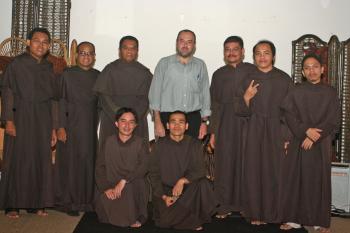 To this vast and varied challenge of the Carmelite friars, one will find in close collaboration: communities of cloistered nuns, Congregations of sisters, Consecrated Lay people, numerous groups of Third Order Lay members and Confraternities of the Scapular of Our Lady of Mt. Carmel. All these groups, born of the Spirit throughout the centuries, and inspired by the Carmelite Rule are intimately united by the bond of love, of spirituality and of the communion of spiritual goods. They constitute the Carmelite Family in the Church. At present the Carmelite Order (the friars) is formed of Provinces, General Commissariats, General Delegations, Hermetical Communities and an Affiliated Community with a total of about 2,000 religious. They are found in all the continents.
To this vast and varied challenge of the Carmelite friars, one will find in close collaboration: communities of cloistered nuns, Congregations of sisters, Consecrated Lay people, numerous groups of Third Order Lay members and Confraternities of the Scapular of Our Lady of Mt. Carmel. All these groups, born of the Spirit throughout the centuries, and inspired by the Carmelite Rule are intimately united by the bond of love, of spirituality and of the communion of spiritual goods. They constitute the Carmelite Family in the Church. At present the Carmelite Order (the friars) is formed of Provinces, General Commissariats, General Delegations, Hermetical Communities and an Affiliated Community with a total of about 2,000 religious. They are found in all the continents.
Please click on the tabs below to scroll through our contact details.
Provincial Centre
Carmelite Provincial Office
75 Wright Street
Middle Park Vic 3206
Tel: +61 3 9699 1922
Email: This email address is being protected from spambots. You need JavaScript enabled to view it.
Prior Provincial
Father Bruce Clark, O.Carm.
Province Executive Assistant
Ms Belinda Ahearn
Business Manager
Mr Joe Konynenburg
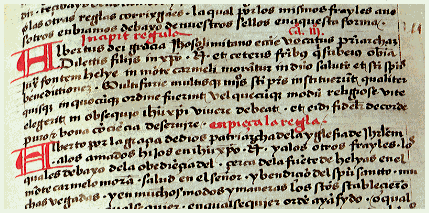 A rule of life was given to the early Carmelites by St Albert Avogadro, Patriach of Jerusalem between the years 1206 - 1214. It was finally approved by Pope Innocent in 1247 and later underwent mitigations which were not in the original text.
A rule of life was given to the early Carmelites by St Albert Avogadro, Patriach of Jerusalem between the years 1206 - 1214. It was finally approved by Pope Innocent in 1247 and later underwent mitigations which were not in the original text.
The Carmelite Rule states that is basic for a Carmelite to "live a life of allegiance to Jesus Christ - how, pure in heart and stout in conscience, he must be unswerving in the service of his Master" [no.2].
The Rule outlines the way to live out the Carmelite life in allegiance to Christ, according to the spirit of the Order. We are to ponder the law of the Lord, by day and by night, in silence and in solitude, so that the word of God may dwell abundantly in the hearts and on the lips of those who profess it. We are to pray with perseverance, especially by keeping vigil and praying the psalms. We are also to be clothed in spiritual armour; to live in fraternal communion, expressed through the daily celebration of the Eucharist, through fraternal meetings in chapters, through shared ownership of all material goods, through fraternal and loving correction of failings, and through a life of austerity, with work and penance, rooted in faith, hope and love, always conforming one’s own will to God’s, sought in faith through dialogue and through the prior’s service to his brothers. (Carmelite Constitutions n.11)
To live a life of allegiance to Jesus Christ, the Carmelites bind themselves especially to:
- develop the contemplative dimension of their life, in an open dialogue with God
- live as brothers, full of charity
- meditate day and night on the Word of the Lord
- pray together or alone several times a day
- celebrate the Eucharist every day
- do manual work, as Paul the Apostle did
- purify themselves of every trace of evil
- live in poverty, placing in common what little they may have
- love the Church and all people
- conform their will to that of God, seeking the will of God in faith, in dialogue and through discernment.
The Carmelite Rule is the shortest of all known Rules, almost exclusively made up of biblical precepts. To this day it is a rich source of inspiration for life.
TEXT OF THE CARMELITE RULE
[1]
Albert, called by God's favour to be Patriarch of the Church of Jerusalem, bids health in the Lord and the blessing of the Holy Spirit to his beloved sons in Christ, B. and the other hermits under obedience to him, who live near the spring on Mount Carmel.
[2]
Many and varied are the ways in which our saintly forefathers laid down how everyone, whatever his station or the kind of religious observance he has chosen, should live a life of allegiance to Jesus Christ - how, pure in heart and stout in conscience, he must be unswerving in the service of his Master.
[3]
It is to me, however, that you have come for a rule of life in keeping with your avowed purpose, a rule you may hold fast to henceforward; and therefore:
[4]
The first thing I require is for you to have a Prior, one of yourselves, who is to be chosen for the office by common consent, or that of the greater and maturer part of you. Each of the others must promise him obedience - of which, once promised, he must try to make his deed the true reflection - and also chastity and the renunciation of ownership.
[5]
If the Prior and the brothers see fit, you may have foundations in solitary places, or where you are given a site suitable and convenient for the observance proper to your Order.
[6]
Next, each one of you is to have a separate cell, situated as the lie of the land you propose to occupy may dictate, and allotted by disposition of the Prior with the agreement of the other brothers, or the more mature among them.
[7]
However, you are to eat whatever may have been given you in a common refectory, listening together meanwhile to a reading from Holy Scripture where that can be done without difficulty.
[8]
None of the brothers is to occupy a cell other than that allotted to him, or to exchange cells with another, without leave or whoever is Prior at the time.
[9]
The Prior's cell should stand near the entrance to your property, so that he may be the first to meet those who approach, and whatever has to be done in consequence may all be carried out as he may decide and order.
[10]
Each one of you is to stay in his own cell or nearby, pondering the Lord's law day and night and keeping watch at his prayers unless attending to some other duty.
[11]
Those who know how to say the canonical hours with those in orders should do so, in the way those holy forefathers of ours laid down, and according to the Church's approved custom. Those who do not know the hours must say twenty-five 'Our Fathers' for the night office, except on Sundays and solemnities when that number is to be doubled so that the 'Our Father' is said fifty times; the same prayer must be said seven times in the morning in place of Lauds, and seven times too for each of the other hours, except for Vespers when it must be said fifteen times.
[12]
None of the brothers must lay claim to anything as his own, but you are to possess everything in common; and each is to receive from the Prior - that is from the brother he appoints for the purpose - whatever befits his age and needs.
[13]
You may have as many asses and mules as you need, however, and may keep a certain amount of livestock or poultry.
[14]
An oratory should be built as conveniently as possible among the cells, where, if it can be done without difficulty, you are to gather each morning to hear Mass.
[15]
On Sundays too, or other days if necessary, you should discuss matters of discipline and your spiritual welfare; and on this occasion the indiscretions and failings of the brothers, if any be found at fault, should be lovingly corrected.
[16]
You are to fast every day, except Sundays, from the feast of the Exaltation of the Holy Cross until Easter Day, unless bodily sickness or feebleness, or some other good reason, demand a dispensation from the fast; for necessity overrides every law.
[17]
You are to abstain from meat, except as a remedy for sickness or feebleness. But as, when you are on a journey, you more often than not have to beg your way, outside your own houses you may eat foodstuffs that have been cooked with meat, so as to avoid giving trouble to your hosts. At sea, however, meat may be eaten.
[18]
Since man's life on earth is a time of trial, and all who would live devotedly in Christ must undergo persecution, and the devil your foe is on the prowl like a roaring lion looking for prey to devour, you must use every care to clothe yourselves in God's armour so that you may be ready to withstand the enemy's ambush.
[19]
Your loins are to be girt with chastity, your breast fortified by holy meditations, for as Scripture has it, holy meditation will save you. Put on holiness as your breastplate, and it will enable you to love the Lord your God with all your heart and soul and strength, and your neighbour as yourself. Faith must be your shield on all occasions, and with it you will be able to quench all the flaming missiles of the wicked one: there can be no pleasing God without faith; and the victory lies in this - your faith. On your head set the helmet of salvation, and so be sure of deliverance by our only Saviour, who sets his own free from their sins. The sword of the spirit, the word of God, must abound in your mouths and hearts. Let all you do have the Lord's word for accompaniment.
[20]
You must give yourselves to work of some kind, so that the devil may always find you busy; no idleness on your part must give him a chance to pierce the defences of your souls. In this respect you have both the teaching and the example of Saint Paul the Apostle, into whose mouth Christ put his own words. God made him preacher and teacher of faith and truth to the nations: with him as your leader you cannot go astray. We lived among you, he said, labouring and wary, toiling night and day so as not to be a burden to any of you; not because we had no power to do otherwise but so as to give you, in your own selves, an example you might imitate. For the charge we gave you when we were with you was this: that whoever is not willing to work should not be allowed to eat either. For we have heard that there are certain restless idlers among you. We charge people of this kind, and implore them in the name of our Lord Jesus Christ, that they earn their own bread by silent toil. This is the way of holiness and goodness: see that you follow it.
[21]
The Apostle would have us keep silence, for in silence he tells us to work. As the Prophet also makes known to us: Silence is the way to foster holiness. Elsewhere he says: Your strength will lie in silence and hope. For this reason I lay down that you are to keep silence from after Compline until after Prime the next day. At other times, although you need not keep silence so strictly, be careful not to indulge in a great deal of talk, for as Scripture has it - and experience teaches us no less - sin will not be wanting where there is much talk, and he who is careless in speech will come to harm; and elsewhere: The use of many words brings harm to the speaker's soul. And our Lord says in the Gospel: Every rash word uttered will have to be accounted for on judgement day. Make a balance then, each of you, to weigh his words in; keep a tight rein on your mouths, lest you should stumble and fall in speech, and your fall be irreparable and prove mortal. Like the Prophet, watch your step lest your tongue give offence, and employ every care in keeping silent, which is the way to foster holiness.
[22]
You, brother B., and whoever may succeed you as Prior, must always keep in mind and put into practice what our Lord said in the Gospel: Whoever has a mind to become a leader among you must make yourself servant to the rest, and whichever of you would be first must become your bondsman.
[23]
You other brothers too, hold your Prior in humble reverence, your minds not on him but on Christ who has placed him over you, and who, to those who rule the Churches, addressed these words: Whoever pays you heed pays heed to me, and whoever treats you with dishonour dishonours me; if you remain so minded you will not be found guilty of contempt, but will merit life eternal as fit reward for your obedience.
[24]
Here then are the few points I have written down to provide you with a standard of conduct to live up to; but our Lord, at his second coming will reward anyone who does more than he is obliged to do. See that the bounds of common sense are not exceeded, however, for common sense is the guide of the virtues.
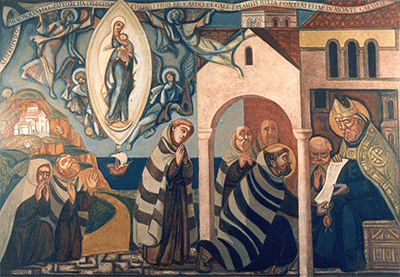
A charism is a gift from God to the Church for the world. With regard to a Religious Order, the term refers to the gift which God gives to an individual or group to inspire the founding of a new religious family within the Church. This gift is handed down through the centuries and enriched by all who are called to live it. The charism of each religious family is the particular way in which its members are called to follow Christ. Since all Christians follow Christ, the charisms will have many elements in common, but the way in which these elements are emphasised gives each religious group its unique feel. All religious families have been asked by the Church to rediscover their original founding charism and make it come alive in each culture and in every age.
The charism of the Carmelite Order is God's gift given originally to those nameless hermits who gathered together on Mount Carmel, beside the well of Elijah, at the end of the 12th and beginning of the 13th centuries. The Carmelite Order has no known founder but sprang from the desire of those first hermits to follow Christ together with a pure heart and a good conscience. They asked the Patriarch of Jerusalem, St Albert, to write for them a rule of life (c.1206-1214) which laid down certain guidelines based on the previous way of life of the hermits.
This Rule of St Albert and the experience of the Carmelites as they sought to be faithful to it in various circumstances gave definitive shape to the charism. We can say that there are several elements which make up the Carmelite charism. Firstly, and most importantly, it is a way of following Christ with total dedication. Carmelites do this by seeking to form contemplative communities at the service of God's people in whose midst they live. Fraternity, service and contemplation are therefore essential values for all Carmelites.
Fraternity
Carmelites seek to form communities where each person feels accepted and valued not for what he can do but simply because he is. This kind of community is in itself a witness that the love of Christ can break down the barriers which human beings set up and that it is possible for people of different backgrounds and nationalities to live together in peace and harmony. Carmelites are also aware of being part of an international fraternity which is present in many parts of the world.
Service
The hermits were forced to leave their home on Mount Carmel and settle in Europe. There they changed their style of life from hermits to friars. The major difference is that friars are called to serve the People of God in some active apostolate. Some Religious Congregations were founded for a specific work but the Carmelite Order tries simply to respond to the needs of the Church and the world which differ according to time and place, and so, many friars work in parishes, schools, universities, retreat centres, prisons, hospitals etc. The kind of service which each individual friar is involved in will depend on the needs of the people in whose midst he lives and his own particular talents.
Contemplation
The heart of the Carmelite charism is prayer and contemplation. The quality of our prayer determines the quality of the community life and the quality of the service which is offered to others. The goal of the Carmelite life is union with God. We seek to live in God's presence and consent to God's will for us. This involves us in listening to God who speaks to us in many ways and especially in the words of Scripture. Prayer is the way we relate to God and as we grow in friendship with Christ our prayer will tend to become more and more simple. The relationship with Christ will change us, impelling us to move out of the prison of selfishness towards the bright daylight of pure love for God and our fellow men and women. We are called to embark on a journey of faith whereby we are gradually stripped of all that is not God so that we can put on Christ. We do all we can to respond to God's initiative in calling us but we are very aware that in the end only God can change our hearts and so we learn to wait patiently for the coming of God to us. As we follow Christ along this path of trust in God we are inspired by the example and virtues of Mary, the mother of Jesus, and the Prophet Elijah.
Prayer and contemplation for the Carmelite are not private matters between the individual and God but are to be shared with others since the charism is given for the whole world. Therefore there is an emphasis in the Order on the ministry of teaching prayer and giving spiritual direction. The Carmelite is aware that the transformation of the human heart by God may be hidden from most eyes but has far reaching consequences for our world. The way of prayer is mysterious and goes beyond our normal human categories. Prayer opens us to the Ultimate Mystery.
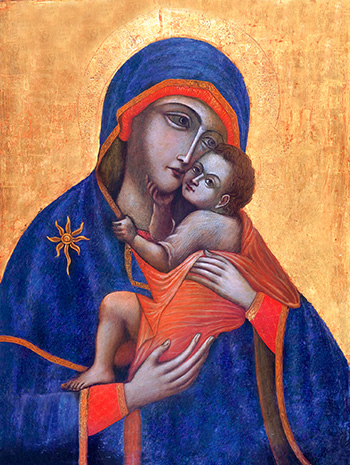 Signs in ordinary human life
Signs in ordinary human life
The world in which we live is full of material things which have symbolic meaning: light, fire, water...
There are also, in everyday life, experiences of relationships between human beings, which express and symbolise deeper realities such as sharing a meal (as a sign of friendship), taking part in a protest march (as a sign of solidarity), joining together in a national celebration (as a sign of identity).
We need signs and symbols to help us understand what is happening at present, or what happened before, and to give us an awareness of who we are, as individuals and as groups.
Signs in Christian life
Jesus is the great sign and gift of the Father’s love. He founded the Church as a sign and instrument of his love. Christian life also has its signs. Jesus used bread, wine, and water, to help us understand higher things, which we can neither see nor touch.
In the celebration of the Eucharist and the other sacraments (Baptism, Confirmation, Reconciliation, Matrimony, Holy Orders, the Sacrament of the Sick) the symbols, (water, oil, the laying on of hands, the rings), all have their own meaning and bring us into communication with God, present in each of them.
As well as liturgical signs, the Church has others related to some event, to some tradition, or some person. One of these is the Brown Scapular of Our Lady of Mount Carmel.
The Scapular is a sign of Mary
One of the signs in the tradition of the Church from many centuries ago is the Brown Scapular of Our Lady of Mount Carmel. It is a sign approved by the Church and accepted by the Carmelite Order as an external sign of love for Mary, of the trust her children have in her, and of commitment to live like her.
The word scapular indicates a form of clothing which monks wore when they were working.
With the passage of time, people began to give symbolic meaning to it: the cross to be borne every day as disciples and followers of Christ. In some religious orders, such as the Carmelites, the Scapular turned into a sign of their way of life. The Scapular came to symbolise the special dedication of Carmelites to Mary, the Mother of God, and to express trust in her motherly protection as well as desire to be like her in her commitment to Christ and to others. Thus it became a sign of Mary.
From Religious Orders to the People of God
In the middle ages many Christians wanted to be associated with the Orders founded at that time: Franciscans, Dominicans, Augustinians and Carmelites. Groups of lay people began to emerge in associations such as confraternities and sodalities.
All the religious Orders wanted to give these lay people a sign of affiliation and of participation in their spirit and apostolate. That sign was often a part of their habit: a cloak, a cord, a scapular.
Among the Carmelites, the stage came when a smaller version of the Scapular was accepted as the sign of belonging to the Order and an expression of its spirituality.
The value and meaning of the Scapular
The Scapular finds its roots in the tradition of the Order, which has seen in it a sign of Mary’s motherly protection. It has, therefore, a centuries old spiritual meaning approved by the Church:
It stands for a commitment to follow Jesus, as did Mary, the perfect model of all the disciples of Christ. This commitment finds its origin in baptism by which we become children of God.
The Blessed Virgin teaches us,
- to be open to God, and to his will shown to us in the people, circumstances and events of our lives;
- to listen to the Word of God in the bible and in life, to believe in it and to put into practice its demands;
- to pray always,as a way of discovering the presence of God in all that is happening around us;
- to be involved with people, being attentive to their needs.
It leads us into the community of Carmel, a community of religious and lay men and women, which has existed in the Church for eight centuries. It calls on us to live out the ideal of the Carmelite family: intimate friendship with God in prayer.
It reminds us of the example of the saints of Carmel, with whom we establish a close bond as brothers and sisters to one another.
It is an expression of our belief that we will meet God in eternal life, aided by the intercession and prayer of Mary.
Some practical rules
People are enrolled in the Scapular only once, by a priest or authorised person.
The Scapular can be replaced afterwards by a medal which has on one side the image of the Sacred Heart of Jesus and on the other the image of Mary.
The Scapular holds us to live as authentic Christians in line with the teaching of the Gospel, to receive the sacraments, to profess our special friendship for Mary, which should be expressed each day – for example, by praying the Hail Mary, prayerful reading of the Scriptures, service to someone in need.
The Carmelite Scapular
is not:
- a magical charm to protect you
- an automatic guarantee of salvation
- an excuse for not living up to the demands of Christian life;
it is:
A Sign which
stands for the decision to follow Jesus as Mary did:
- open to God and to God's will,
- guided by faith, hope and love,
- close to the needs of people,
- praying always,
- discovering God present in our life;
brings people into the family of Carmel;
with Mary's help, strengthens our desire to be with God forever.
Rite of Enrolment in the Brown Scapular
As we attempt to follow Christ more closely, we Carmelites find inspiration in the Old Testament Prophet, Elijah, and in the Blessed Virgin Mary.
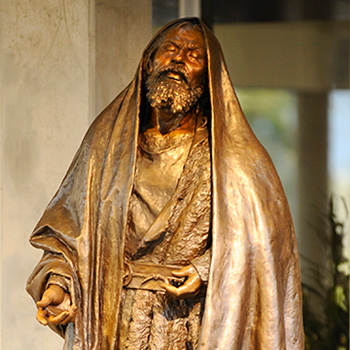 The Prophet Elijah
The Prophet Elijah
Elijah's memory was kept alive especially on Mount Carmel where he challenged the people to stop hobbling first on one foot and then on the other but to choose who is God in Israel - Yahweh or Baal. According to the story, which can be found in the First Book of Kings, chapter 18, Elijah's sacrifice was consumed by fire from heaven which proved to the people that Yahweh was the true God.
Elijah in the presence of the Lord on Mount Horeb
Elijah made himself available for God's work and was sent into various situations to proclaim God's word. Elijah undertook a long journey through the desert where he began to despair. He sat down under a bush and wished he were dead but God would not allow him to die and prodded him to continue his journey to Mount Horeb. When he arrived there, God became present to Elijah. God came not with the signs usual in the Old Testament of fire, earthquake and mighty wind but in the sound of a gentle breeze. Elijah was sent back to his people to carry out God's will.
From Elijah, Carmelites learn to listen for the voice of God in the unexpected and in silence. We seek to allow the Word of God to shape our minds and our hearts so that the way we live and the things we do may be prophetic and therefore faithful to the memory of our father Elijah.
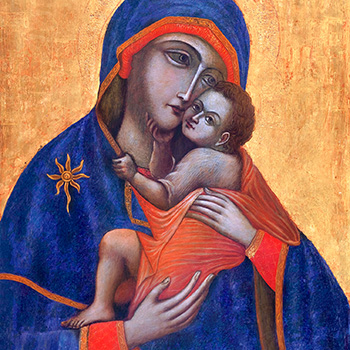 The Blessed Virgin Mary
The Blessed Virgin Mary
The first hermits on Mount Carmel built a church in the middle of their cells. This was the centre of their lives where they converged each day to celebrate Mass together. This little church they named in honour of Our Lady. By this fact the first group of Carmelites took her as their patroness, promising her their faithful service and expecting her protection and favour. They were proud to bear the title of "Brothers of the Blessed Virgin Mary of Mount Carmel" and they defended this title with vigour when their right to it was challenged.
Mary ever ready to accomplish the wish of God
Mary consented to God's will when she was asked to be the mother of the Saviour. She pondered on the events of her life and was able to see in them the hand of God at work. Mary did not become proud about her unique vocation but instead praised God for looking on her lowliness and doing great things in her. She was with Jesus at the beginning of his public ministry when, at the marriage feast at Cana, she made known to him the simple need, "They have no wine". She was with him as he died and there she became the mother of all believers. At the beginning of the Acts of the Apostles we find Mary gathered in the upper room praying with the other disciples waiting for the outpouring of the Holy Spirit. For us Carmelites, Mary is a constant presence in our lives, guiding us and protecting us as we seek to follow Christ.
The brown scapular has for many centuries summed up the Carmelite's relationship with Our Lady. The scapular is a piece of cloth based on the traditional Carmelite friar's garb. Wearing the scapular is a sign of consecration to Mary, the Mother of God, and is a symbol showing that the person is putting on the virtues of Mary and is being protected by her.
Mary symbolises for the Carmelite everything that we hope for - to enter into an intimate relationship with Christ, being totally open to God's will and having our lives transformed by the Word of God. Carmelites have always thought of Mary as the Patroness of the Order. We seek to live in spiritual intimacy with her so that we can learn from her how to live as God's children.
Elijah and Mary are inspirational figures for all Carmelites. They play a very important part in the life and spirituality of the Order which sees itself as belonging to Mary and looks to Elijah as our spiritual father.














